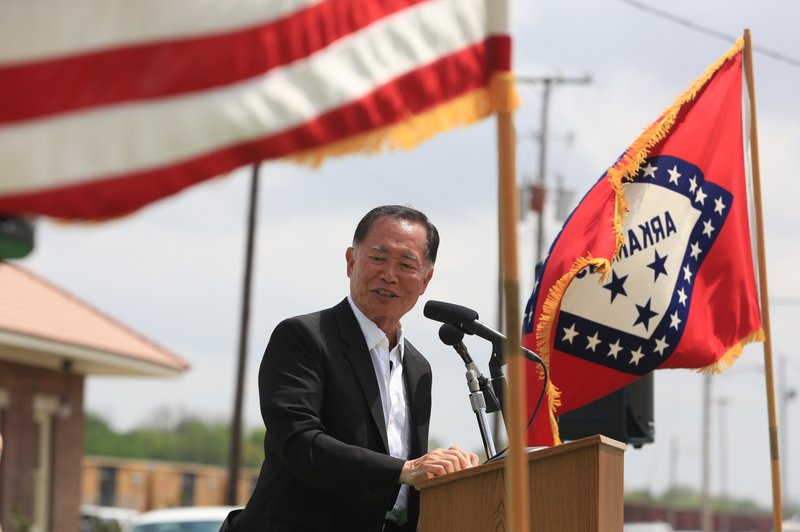there may be a familiar ring to the voice on the recently installed audio kiosks at Rohwer Japanese American Relocation Center. It’s that of Mr. Sulu, the USS Enterprise’s helmsman and in real life, the actor George Takei.
Interned as a 5-year-old with his family at Rohwer, Takei returned to the Desha County site four months ago. He was the featured guest for dedication of the new exhibits at the former camp, along with opening of the Jerome-Rohwer Interpretive Museum and Visitor Center in nearby McGehee.
Thanks to these additions, visitors can get a fuller and more vivid sense of what it was like for U.S. citizens - selected because of their ancestry - to find themselves held under armed guard behind barbed wire.
After the Japanese attack on Pearl Harbor, about 120,000 Japanese-Americans were transported from the West Coast in 1942 without any legal proceedings to 10 camps, including Rohwer and Jerome in southeast Arkansas. Most were confined until near war’s end.
Now 76 and a noted human-rights activist, Takei describes his family’s forcible shipment as “the most defining moment of my life. We were imprisoned because of fears, misunderstanding and racial prejudice.”
His seven commentaries total roughly 13 minutes as visitors move from one button-activated recording to another. They enliven a setting otherwise flat and empty except for four memorials, a flagpole flying the Stars and Stripes and 24 gravestones of Japanese-Americans who died while interned. In the distance rises a towering chimney that served the camp’s hospital.
At a kiosk near the spot where Takei’s family was housed - Block 6, Barracks 2, Unit F - he recalls that his father built shelves and stools to furnish the single room where parents and three children lived with only a stove and cots provided by authorities.
He remembers reciting the U.S. Pledge of Allegiance each morning at school while looking out at the barbed wire that surrounded the camp. He recalls the lack of privacy, a fact emphasized by one of the informational signs: “Internees had little privacy. The barracks housed several families and included only canvas cots, some bedding, a pot-bellied stove and bare light bulbs. Internees provided their own cooking utensils, housekeeping items and any other furnishings. Communal bathrooms, initially built without dividers, were particularly humiliating for many internees.”
Restoration work is proceeding this summer on the site’s monuments. The most telling is a memorial erected after World War II that lists 31 Rohwer internees who went on to join the much-decorated Japanese-American 442nd Combat Brigade and died in Italy, France and Germany.
On one of the new kiosk markers, President Harry S. Truman honored members of the 442nd at the White House in 1945 and told them, “You fought not only the enemy but prejudice. And you won.”
Federal funding, along with efforts spearheaded by Ruth Hawkins at Arkansas State University at Jonesboro and Johanna Miller Lewis at the University of Arkansas at Little Rock, have driven the Rohwer improvements and museum opening in McGehee.
Housed in the city’s former train station, the museum presents “Against Their Will,” a permanent exhibit about Arkansas’ two camps that was created by UALR. Visitors can also watch Time of Fear, a public television video about the internments.
Among the museum’s most impressive exhibits are paintings of camp life by internee Henry Sugimoto. A display panel notes President Ronald Reagan’s signing of a bill passed by Congress in 1986 that formally apologized to Japanese-Americans and awarded reparation of $20,000 to each person interned.
To reach Rohwer Japanese American Relocation Center, some 100 miles southeast of Little Rock and a dozen miles north of McGehee, drive about a half mile north from the town of Rohwer on Arkansas 1. Then turn left at the directional sign for the National Historic Landmark. The unattended site is open daily free of charge.
The Jerome-Rohwer Interpretive Museum and Visitor Center (also known as the Japanese American Internment Museum) in McGehee’s former train station, 100 S. Railroad St., is open 10 a.m.-5 p.m. Tuesday-Saturday. Admission is free. Call (870) 222-9168
For lunch in McGehee, a popular spot is Hoots BBQ, 2008 U.S. 65 N.
Weekend, Pages 35 on 08/15/2013
